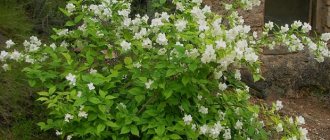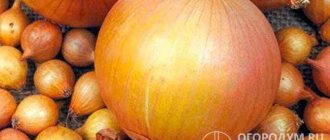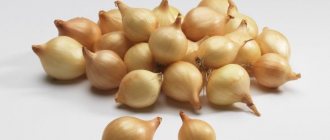The rose, the queen of flowers, has been grown by humans as a cultivated plant for about 5,000 years. Persia (today's Iran) is considered to be the birthplace of the flower, although the first mentions of the rose were found in ancient Indian chronicles. In the tombs of Egypt it was found on the chests of mummies, the crusaders attached the rose to their swords, ancient temples were decorated with garlands of it. In the East, the rose was considered a sacred flower, which arose from drops of sweat of the Prophet Mohammed.
In Jerusalem, the only flower that is allowed to be grown in gardens and parks is the rose; other flowers are only allowed outside the city. Today, a huge number of varieties of roses have been bred, which are divided into several groups, although this classification is purely conditional.
Some of the most luxurious and famous varieties are hybrid tea roses, of which there are about 10,000 varietal varieties. Among them there is a unique variety - the Gloria Dale rose, which means Glory to the Lord. The variety was awarded the title “Rose of the 20th Century”. The variety was bred by the French breeder F. Meillan and named in memory of his mother.
Hybrid tea roses, general characteristics
The hybrid tea rose is considered an “aristocrat” among roses. This species received its name as a result of crossing an old tea rose and a remontant variety. In 1867, the French breeder Jean-Baptiste Andre Guillot crossed the Chinese tea rose "Madame Bravie" with the remontant variety "Madame Victor Verdier".
The result was the first hybrid tea rose, named La France. In 1893, hybrid tea roses were officially recognized as a separate class. In catalogs they are classified as Large-flowered.
Hybrid tea roses inherited the aroma of fresh tea, beautiful large flowers and long flowering from tea roses, and resistance to diseases and resistance to unfavorable climatic conditions from the remontant variety. Some varieties of hybrid tea roses are not suitable for growing in garden plots; they are cultivated only for exhibition purposes.
La France
Caring for roses in the open ground
Caring for roses is not much different from caring for other flowering plants. The crop requires watering, fertilizing, pruning, in some cases attaching the bush to a support, and pest control. When planted in spring, the rose will bloom the same year.
Watering
A newly planted seedling is watered frequently, every 2-3 days. After the rose takes root and produces new shoots, it begins to be watered more moderately. The top layer of soil should dry out between waterings. The exception is the period of bud formation - at this time the plant will again need an increased amount of moisture.
Irrigation procedures are best carried out in the morning or evening. When watering during the day, the water will evaporate too quickly. The moistened soil must be loosened so that a hard crust does not form on top. At the same time, you can weed the root zone of the rose.
Feeding
Rose is a plant that is responsive to fertilizing. It is best to alternate the application of organic and mineral fertilizers. Granules or organic matter are scattered under the bush and dug up along with the soil, after which they are watered or nutrient solutions are used. In the first year of planting, the rose does not need fertilizers, since they were applied to the planting hole. During the season, the rose bush is fed four times:
- during spring feeding, both organic and mineral fertilizers are applied at once;
- during the formation of rose buds, it is necessary to fertilize with an infusion of mullein or bird droppings;
- before flowering, complex mineral fertilizer with a predominance of potassium and phosphorus is applied;
- in preparation for winter, the rose is fertilized with a mixture of humus and compost.
Fertilizing prolongs the flowering of the crop, the flowers are larger and brighter. All fertilizers are given in moderation; overdoses can harm the plant.
Trimming
Pruning roses has a sanitary purpose and serves to form a bush. Sanitary pruning is carried out twice a year - in spring and autumn. Before wintering, remove damaged, immature and diseased shoots. In the spring, branches that have frozen or dried out during the winter are cut out.
In order to form a bush, pruning is carried out three times a season. In spring, low-growing shoots are pruned above the 4th bud, tall shoots - above the 8th. In the summer, those branches on which flowering occurred are shortened so that the plant does not waste energy on setting fruit. In the fall, during sanitary pruning, the overall shape of the bush is adjusted.
On a note! Autumn pruning is carried out no earlier than November, so that the shoots do not start to grow. Young immature branches will inevitably freeze.
Hybrid tea rose - pruning in summer: video
Garter
Roses grown on a trunk need to be attached to a support. During flowering, such a bush will become too heavy and may break off after rain or under the influence of strong winds. For tying, use twine or soft fabric so that the material does not cut into the shoots. A figure eight type garter is used. You can use a wooden peg or a decorative metal structure as a support. Periodically inspect the plant and, if necessary, loosen the tied knots.
Description of the hybrid tea species
The height of the bush is about 60-90 cm, some varieties reach 2 meters
The shape of the bush is narrow pyramidal or spreading; it can be grown in the form of a trunk.
The leaves are shiny or matte, large, the color of the leaves is bright green.
The flower is large, double, up to 15 cm in diameter, the structure of the flower is classic.
The flower shape is cone-shaped, cup-shaped, goblet-shaped.
The number of petals is from 70 to 130 pieces.
Petal color : from white to black-red, can be multi-colored depending on the variety. A feature of some varieties is a change in color in different phases of flowering.
The aroma may be strong or weak.
One or several buds (up to 7 pieces) are grown on the stem
Flowering is long, from June to September.
They require shelter for the winter and freeze at temperatures below 10 degrees below zero.
Diseases : black spot, powdery mildew.
Hybrid tea roses also have some disadvantages. There are varieties with unattractive bushes, short-lived flowering in damp, rainy weather, or insufficient formation of buds after wintering.
Hybrid tea roses are divided into subgroups according to different criteria, but the most common and convenient classification of this type of rose is based on the color and color of the petals.
Fertilizing
To ensure abundant and long-lasting flowering of hybrid tea roses, it is necessary to perform timely and correct fertilizing. The combination of organic and mineral fertilizers demonstrates excellent efficiency. The former improve the composition of the soil and nourish the rose, the latter enhance its growth and make flowering last longer.
The first year, root feeding is excluded - it was carried out at the time of planting. In autumn, you can add nutrients to the leaves: dilute 1 tbsp. l. potassium sulfate in 8 liters of water.
The following year, fertilizing is carried out in the spring, which allows for increased growth. Mineral dry fertilizers are used, sold in specialized stores. First, the bush is watered with water, then the fertilizer is scattered around - they retreat 10 cm from the central stem. The substances are embedded in the ground and watered again.
After 7 days, organic matter is added: 5 liters of mullein is placed around the bush and mixed with the soil with a rake. At the end of the procedure, watering.
During the period of bud formation, organic matter is again introduced. An infusion of chicken or cow manure is perfect for this case It is prepared in advance: 1 liter of manure is taken and diluted with 8 liters of water. The mixture is infused for 2 weeks, then diluted with water in a ratio of 1 to 5 and watered.
At the same time, foliar feeding is carried out with an infusion of wood ash. The last stage of fertilizing this variety of roses occurs in September - organic matter is added in any form.
Lilac and blue varieties
Blue Moon variety
Translated into Russian, the flower is called “Blue Moon”. The variety was created in Germany in 1964.
- Bush 90 - 120 cm high, neat, practically no thorns
- Leaves are dark green, very shiny
- Petal color: lilac, does not fade, becomes pink in the shade, blue in the sun
- Flowers with a diameter of 10-13 cm, large, double, up to 36-40 petals
- The aroma is strong, rich
- Disease resistance is average, requires spraying against powdery mildew, is not afraid of rain
- Winter hardiness is high, but it is advisable to cover
- Grown for cutting, has a long stem.
Variety Charles de Gaulle
The variety was created and dedicated to the songs of Mireille Mathieu in 1975, which Charles de Gaulle loved very much. At her request, he became the godfather of her younger brother.
- Bush up to 1.2 meters high, erect, with long thorns
- Leaves are dark green, glossy
- Petal color: lavender-colored petals, when blooming they become bluish-lilac
- Flowers with a diameter of 13-14 cm, goblet-shaped, double, up to 40 petals, wavy edges
- The aroma is strong with notes of citrus and verbena
- Disease resistance is high, but preventive spraying is needed
- High winter hardiness, does not require shelter
- Grown for cutting and for bouquets, it is a particularly valuable variety.
Blue Nile variety
Created in France in 1981, in the same year it received the Bagatelle gold medal as a new variety at an international competition in Paris.
- Bush up to 150 cm high, prickly
- Leaves are dark green, glossy
- Petal color: bluish-lilac
- Flowers up to 12 cm in diameter, double, up to 35 petals
- The aroma is pleasant, with notes of citrus and tea, the smell attracts bronzes (minus)
- Disease resistance is average
- Winter hardiness is above average, requires shelter
- Grown for cutting and garden decoration.
Disease treatment and pest control
Hybrid roses are susceptible to various diseases, powdery mildew is especially common. Let's look at the most common diseases and methods of their treatment:
- Powdery mildew - manifests itself as a white or grayish coating on the leaves and shoots. The cause of the disease can be a high nitrogen content in the soil, lack of sunlight or too much moisture.
- 1. For prevention, use 40 g of soda diluted in a liter of water. The resulting solution is sprayed on the bush in the spring. The procedure is repeated 2 times a week until the end of June.
- 2. Treatment consists of the use of special drugs - Topaz or Fundazol.
- Rust is noticeable on the budding buds in the form of orange dust. Spots appear on the foliage that have a convex shape and a corresponding color. At the end of summer the spots turn black. The bush and soil should be sprayed with iron sulfate in March. If the buds have blossomed, the drug Ordan is used. The affected areas are cut out and burned.
- Black spotting occurs at the end of July. A characteristic sign will be not only black spots, but also falling leaves. If the plant tries to grow green mass again, it takes a lot of energy, which prevents it from preparing for winter and results in death or severe illness. Densely planted roses without sanitary pruning are most at risk. Treatment is similar to the previous case; the drug Skor is also suitable - it is used to eliminate the disease and prevent it.
- Gray rot - affects the buds and young shoots of hybrid tea roses. It looks like a gray fluffy coating. Plants that are located next to the strawberry planting often get sick; the latter is highly susceptible to the disease. Prevention consists of maintaining a distance when planting and watering exclusively in the evening. Treatment is similar to powdery mildew.
Among the pests, the plant most often attacks the green aphid. To fight, a soap solution is used: a bar of laundry soap is rubbed into a bucket of water, then the mixture is boiled for 15 minutes, infused and filtered. The substance is sprayed on leaves and shoots, the procedure is repeated after 7 days. If there are a large number of pests, you can use insecticides that are sold in the store.
Multi-colored varieties
Variety Hocus Pocus (Hokus Pokus)
- Bush up to 75-80 cm high, branched, has thorns
- Leaves are green, glossy
- Petal color: dark red color has golden streaks, one bush can have flowers of different colors, there are no identical flowers
- Flowers up to 7 cm in diameter, double
- The aroma is weak
- Disease resistance is average
- Winter hardiness is weak, requires shelter
- Grown for cutting, lasts up to 16 days, good for borders
Variety Satin
- Bush 70-90 cm high
- Leaves are dark green, matte
- Petal color: bright crimson, with white stripes
- Flowers with a diameter of 8-10 cm, goblet-shaped, double, up to 45 petals
- The aroma is light
- Resistance to diseases is average, resistance to rain is weak
- Winter hardiness is good, does not require shelter
- Grown for flower beds, landscape design
This type of rose requires careful care and individual agricultural technology, depending on the variety.
Variety Satin
- Bush 70-90 cm high
- Leaves are dark green, matte
- Petal color: bright crimson, with white stripes
- Flowers with a diameter of 8-10 cm, goblet-shaped, double, up to 45 petals
- The aroma is light
- Resistance to diseases is average, resistance to rain is weak
- Winter hardiness is good, does not require shelter
- Grown for flower beds, landscape design
This type of rose requires careful care and individual agricultural technology, depending on the variety.
Golden Masterpiece
This “golden masterpiece” will appeal to lovers of yellow flowers. The very large (diameter from 10 to 19 cm) and slightly elongated golden yellow buds of this hybrid tea rose exude a very pleasant aroma and do not fade in the sun. In addition to incredibly beautiful flowers, the powerful bush is decorated with shiny green leaves. But in order for the buds to remain bright, the plant must be planted in a sunny area.
The variety is resistant to diseases, especially powdery mildew.
| Purpose | Plant height | Bloom | Aroma | Winter hardiness |
| 80-95 cm | Abundant, continuous all summer | Nice, saturated | Average (needs in shelter) | |
Basic mistakes when growing
| Errors | Right |
| Wrong landing place | The rose is light-loving, does not grow well in the wind, does not like excessive watering |
| Incorrect landing | The grafting site should be 3-4 cm below the soil surface. If deeply buried, the root collar may rot |
| Incorrect summer pruning | It is necessary to remove faded flowers |
| Improper watering | The bush requires 5-10 liters of water once every 5-7 days in the evening |
| Wrong fertilizers | During the budding period, potassium and phosphorus fertilizers are needed |
| Improper preparation for winter | It is necessary to remove all leaves, cover only after the first frost. |
Planting roses on the site
The moment of planting roses on the site is of great importance, because the bushes will grow for many years. It is important to choose the right place, prepare the soil, and plant the plant at the right depth.
Selecting a location
The place for planting roses should be sunny and protected from the wind. These flowers do not tolerate drafts. It would be good if they were protected on the north side by the walls of a building or a high hedge of bushes. If the groundwater level is high in the area, it is better to plant the rose bush in an elevated place.
Suitable soil
The soil for roses should be fertile, loose, well-permeable to water and air, and have an acid reaction closer to neutral or slightly acidic. Before adding additives to the planting hole, take into account the type of base soil.
Coarse sand and peat are added to clay soil. Humus and compost are added to the sandy soil. If it is necessary to reduce acidity, wood ash, chalk or dolomite flour are placed in the hole when planting. Additionally, fertilizers are applied.
Landing rules
The planting hole should be large enough to accommodate the root system of the seedling. The roots should be located freely in the hole and not be bent. Then proceed like this:
- In dense soil, crushed stone drainage is laid at the bottom; light soil is simply loosened.
- Then add organic fertilizer in the form of compost or humus.
- The fertilizer is sprinkled with a small amount of soil on top so that it does not have direct contact with the roots; a mound should form.
- The seedling is placed in the center of the hole, the roots are straightened, and the hole is half filled with soil.
- Pour a bucket of water in small portions and wait until the moisture is absorbed.
- Add the remaining soil; when planting, the root collar should be buried 2-3 cm.
- Water the root zone again and allow the water to be absorbed.
After planting, the ground is mulched with peat, sawdust, and compost. Now it is necessary to provide the seedling with careful care so that it takes root well in its new place.
Hybrid tea roses. Landing features: video
Lucky Piece
On a dense but rather compact bush, incredibly beautiful, densely double (45-50 petals) cup-shaped flowers (10-12 cm in diameter) bloom throughout the summer. Most often they are collected in inflorescences of 3-6 pieces. The unusual color of the buds is simply mesmerizing: on the upper side the petals are apricot-pink, and on the lower side they are orange-red.
The Lucky Peace variety is resistant to powdery mildew and black spot. For abundant flowering, the rose should be planted in a well-lit place and fed from May to July once every 2 weeks. At the same time, complex mineral and organic fertilizers are alternated.
| Purpose | Plant height | Bloom | Aroma | Winter hardiness |
| Up to 80 cm | Abundant, repetitive all summer | Easy | Average (needs in shelter) | |
General information
However, the culture is distinguished by its capricious character and unstable immunity. Due to these factors, regular and proper care is important. Anyone who wants to start this culture needs to study and follow the recommendations of professionally knowledgeable specialists. A lot of effort will be spent, but the favorable result will be very pleasing.
Cultivation of this plant is mainly carried out by grafting; a few varieties are propagated by cuttings.
Planting and care in open ground. Roses are planted in the first days of May. Slightly acidic and fairly loose soil, unobstructed sun and protection from windy weather are ideal. All soil is removed from the roots of the planting material. Before planting, the bushes are placed in a container with water for drinks for two to three hours. If the whole plant fits in, then that’s great! If this condition cannot be met, the roots, the grafting site, are completely immersed in water.
The size of the hole varies from thirty to fifty cm, the distance between the bushes is the same. It is not recommended to grow more than eight units on one plot. Even before planting, be sure to soak the roses in a tincture - one part manure, one part water and a couple parts clay. After planting the crop, they form a roller of soil to retain water near the root system. The last stage - hilling - at least fifteen cm.
Roses are cultivated in open and closed soil. First of all, the conditions directly depend on the weather conditions in the growing area. A lot of buds are formed on annual shoots. For this reason, all bushes need to be pruned in the spring.
In the very first year of life, the bush is cut into two to three buds, later - into five to seven buds. When pruning in summer, the number of sprouts increases, and this is the key to rapid re-blooming. Knowledgeable experts do not recommend cutting more than two flowers from one bush, as this will lead to weakening of the entire plant. Before wintering, the rose is pruned on the last days of October. Absolutely everything is removed and burned. Covered with a cap of spruce branches. In severe frosts, a frame structure is installed and reliably insulated.











